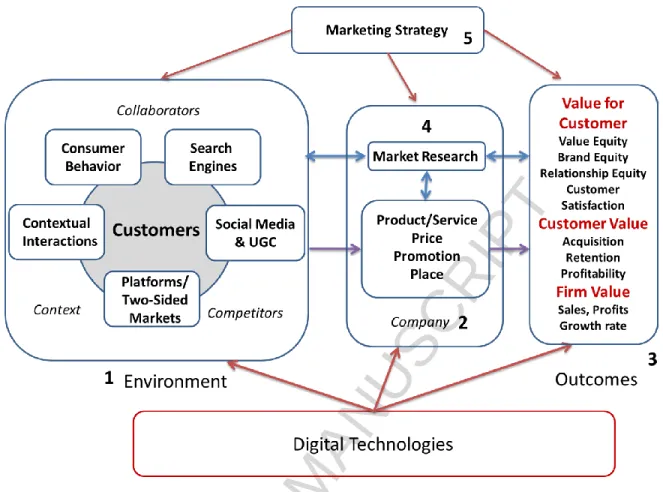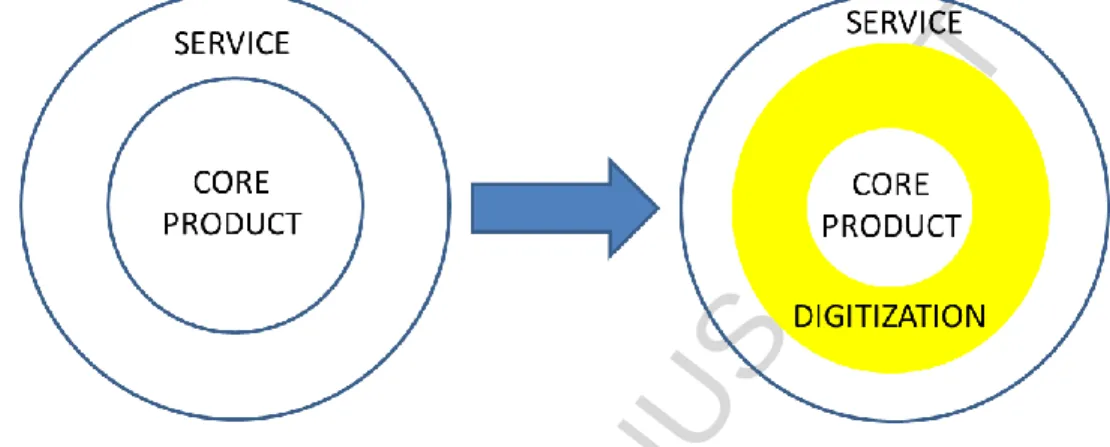We develop and describe a framework for research in digital marketing that highlights the touchpoints in the marketing process and in the marketing strategy process where digital technologies have and will have a significant impact. First, we develop and describe a framework for research in digital marketing that highlights the touchpoints in the marketing process and in the marketing strategy process where digital technologies have and/or will have a significant impact.

ACCEPTED MANUSCRIPT
Digital Environment
- Consumer Behavior
- Social Media and User-Generated Content
- Platforms and Two-Sided Markets
- Search Engines
- Contextual Interactions
Many of the research findings in the general research field can be applied to specific digital settings. Godes and Mayzlin (2004) were the first researchers to investigate the impact of online review. They examined the volume and distribution of online review and found that distribution is a good predictor of a television program's ratings.
They found that as the search ad is placed at the top of the results page, the CTR is higher.
Marketing Actions 1 Product
- Price
- Promotion
- Place
An early trend in the digitization of the basic product with added service is the transformation of products and associated services into digital services in the field of information products - software, music, video, text, video games, etc. An important impact of the digital environment on product strategy is the facilitation of mass customization. He found that the model based on the customer's expected response to a recommendation works better than traditional recommendation methods that simply recommend an item that a customer is most likely to buy based on past preferences.
With ever-increasing spending on display advertising, there has been extensive research into determining the effectiveness of display advertising. Recently, Hoban and Bucklin (2015) conducted an experiment that investigated the impact of display advertising at different stages of the purchase funnel. 2015) examined daytime promotions and found that depending on the type of product promoted (utilitarian vs. hedonic), promotional effectiveness varied.
In addition, they found differences in the attention consumers pay to the level of the discount depending on the time limit of the offer of the day. Multichannel issues in the context of the digital environment can be viewed from two perspectives. One of the advantages of the digital environment from a business perspective is that it is much easier to obtain data about specific customer touch points with the business.

Marketing Outcomes
Future research could also focus more on the shopping behavior of various segments, regarding when, where and how to reach them. In a related study, Danaher, Wilson, and Davis (2003) compared consumer brand loyalty in online and traditional shopping environments for more than 100 brands in 19 grocery product categories. They found that perceived brand loyalty for high market share brands purchased online was significantly greater than expected, with the opposite result for low share brands, while there was no such difference in the offline setting.
An illustration of research linking an environmental element directly to an outcome variable is Sonnier, McAlister, and Rutz (2011), who focused on the sales effect of the extent of positive, negative, and neutral online interactions with customers. They modeled daily measures of online word of mouth about a company and its products as contributors to a latent demand generating inventory variable and found a significant effect of positive, negative, and neutral eWOM on daily sales performance. Later, McAlister, Sonnier, and Shively (2012) extended this analysis to firm value and found that online chat has a significant effect on firm value, while ruling out all possible alternative explanations for this result. studied the economic value implications of social trading in online social networks where the sellers are individuals.
They found that allowing sellers to connect with customers can generate significant economic value in terms of sales with the value of the network that results. mainly from the access that customers have to the market, thus emphasizing the inherent value of networks for both customers and sellers. 2016) studied the impact of firm-generated content in social media sites on individual customer purchases in and across product categories and found that firm-generated content the. One of the important aspects of the above research linking digital environment and firm action is the rigor to ensure that alternative explanations are excluded.
Marketing Research
Moe (2003) used clickstream data to empirically test a typology of store visits that varied with shopper's underlying goals – buying, browsing, searching or knowledge building – and was able to categorize visits using the behavioral data. Trusov, Bodapati and Bucklin (2010) focused on identifying the influential members in a social network - the influencers - who can then be the target for a firm hoping to propagate their message. The authors developed an approach to determine the specific users who have significant effects on the activities of others using the longitudinal records of members' login activity.
Using the measures of network structure, their model focused on predicting the next set of adopters given a set of previous adopters. There is a developing stream of research that uses the data generated in the digital. Specifically, they found that the volume of UGC chat has a strong positive impact on abnormal returns and trading volume, with the effect of negative and positive valence of UGC being asymmetric.
They also found that an increase in offline advertising significantly increases chatter volume and reduces negative chatter. Nam and Kannan (2014) used social tagging data and developed tag-based metrics that acted as proxy measures of customer-based brand value and explained abnormal returns. This stream of research shows that digital environmental data can contain very useful information for tracking the business environment.
Marketing Strategy
Much remains to be explored using such data and our agenda for future research in Chapter 8 will outline some of the possibilities that exist in that area. For example, Haenlein (2013) examined the impact of social interactions on churn and reported that churn is higher for a customer connected to previous churn. 2013) discussed how social media would reshape the world. Given that some elements of customer value are significantly influenced by the digital technologies, such research calls for a more inclusive definition of customer value.
In this content, Lemon and Verhoef (2016) and Kumar and Reinartz (2016) provided useful frameworks for understanding the role of user experience and customer engagement provided by digital technologies in creating customer value and increasing customer lifetime value. The emphasis in brand management is on understanding how a brand is created, changed and strengthened in and through the digital landscape. 2016) described how social media sites created a resounding “echo” for a brand. They found that while companies benefit from using social media for personalized customer responses and online brand communications, traditional branding.
Batra and Keller (2016) have provided an overview of these synergies in the context of brand communication. A company's brand positioning strategy can be influenced by their search engine marketing (SEM) and search engine optimization (SEO) strategies (Dou et al. 2010). As new digital devices and technologies evolve, future research should focus on how companies can leverage these developments to create sustainable competitive advantage, gain market share, and increase customer value and brand equity.
Agenda for Future Research
- Environment
- Company
- Marketing Outcomes
- Marketing Strategy
There is a critical need for theories of consumer behavior that explain the psychological motivations for using devices such as mobile and wearable computing (e.g., Belk 2013, Hoffman and Novak 2015). How consumers' cognitive abilities and experiences change in the context of using a new device. In the context of the customer journey, one must understand the specific roles each digital touchpoint plays in the overall consumer decision (search, display ads, recommendations, email). One of the most important directions for future digital marketing research will be in the area of cross-device and cross-channel marketing.
Research into methodologies that provide real-time, accurate targeting across platforms and the development of intermediaries that can assist in such personalization will be essential in the digital space. Significant research has been conducted in the areas of online ratings, reviews, social media interactions and online chat. For example, Amazon has emerged as a behemoth in the retail domain, completely changing the competitive landscape using the online channel.
There are recent examples of travel intermediaries benefiting from the introduction of mobile applications in the travel and hospitality industry and strengthening their competitive position in the market vis-à-vis hotel chains. How can the firm use the technology to better promote their product/service (cf. geo-targeting and coupons in the case of mobile devices). This will become an important topic of investigation in the coming days.
Conclusion
Click here for Internet Insight: Advances in Clickstream Data Analysis in Marketing, Journal of Interactive Marketing. 2014), The Structure of Customer Orientation for Firms Using B2B Internet Platforms, Journal of Marketing, Vol. Interplay of discount and time constraint with product type, International Journal of Research in Marketing.
2016), The Path to Purchase and Attribution Modeling: Introduction to Special Section, International Journal of Research in Marketing Optimizing a Menu of Multi-format Subscription Plans for Ad-Supported Media Platforms, Journal of Marketing, (forthcoming). Self-selection and informational role of online product reviews. 2001), Choice menus for mass customization: An experimental approach to analyzing customer demand with an application to a web-based information service, Journal of Marketing Research, Vol. 2000), Modeled to bits: Decision models for the digital, networked economy, International Journal of Research in Marketing, Vol. 2015), Improving online idea generation platforms and adapting the task structure based on consumers' domain-specific knowledge, Journal of Marketing, Vol.
Shankar, V, Smith, A.K., Rangaswamy, A (2003), Customer satisfaction and loyalty in online and offline environments, International Journal of Research in Marketing, Vol. 2010), Mobile Marketing in the Retailing Environment: Current Insights and Future Research Avenues, Journal of Interactive Marketing. Offline and online search in used durable knife markets. 2010), Don't think twice, it's right: music piracy and pricing in a DRM-free environment, Journal of Marketing, Vol. Mining Marketing Meaning of Online Chatter: Strategic Brand Analysis from Big Data Using Latent Dirichlet Allocation, Journal of Marketing Research.